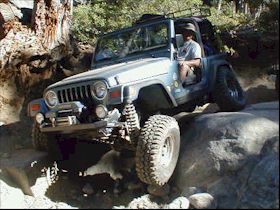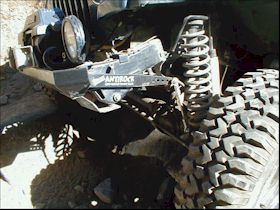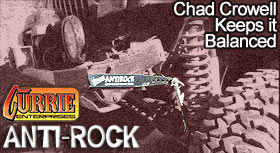|
|
|
 OFF-ROAD
DRIVING
OFF-ROAD
DRIVINGI was able to test out the Currie at the same time I tested the new Rubicon Express lift. I went to Bassi Falls, a small off-road area near the Rubicon, and spent two days playing with the new setup.
My first concern was that the Anti-Rock would limit my front axle droop, causing decreased traction by not allowing to axle to move downward as far as it could with a completely disconnected sway bar. Well, the axle was limited by maybe 3” or so, at most. With the massive amount of droop I get out of the RE kit, this difference is not enough to cause any heartache. I still felt that the Jeep was stretching its legs and the tires were staying in contact with the terrain.
I also tried to “feel” the Jeep's balance. I had gotten used to how the body followed the rear-end over the years, and my driving style was in tune with that. Driving with the Anti-Rock definitely changed the way the Jeep moved as it traveled over uneven terrain. Instead of the TJ sitting back while the front axle reached out for traction, the body would move somewhat with the front axle, while allowing the rear axle to stay put or move in the other direction.
 In some cases, this felt better
than it had before, and seemed to aid the traction by putting more weight
toward the side of the front axle that was drooping. In other areas,
off-camber ones to be exact, it took some getting used to, as the body
would lean downhill if the downhill, front tire began to droop. Still,
it never made the Jeep feel unstable or more roll-over-prone. It was
just different from what I had learned before.
In some cases, this felt better
than it had before, and seemed to aid the traction by putting more weight
toward the side of the front axle that was drooping. In other areas,
off-camber ones to be exact, it took some getting used to, as the body
would lean downhill if the downhill, front tire began to droop. Still,
it never made the Jeep feel unstable or more roll-over-prone. It was
just different from what I had learned before.
A side benefit of the Anti-Rock is that my shocks had always been the axle limiter before, and now the Anti-Rock kept them from over-extending and having the axle weight pulling down on them. It seems to me, this would extend the life of the shocks.
Overall, there is a difference in the way the Jeep walks over rocks and ditches, and the difference is quite perceptible. I was never uncomfortable with the way my Jeep performed in the past, and the addition of the Anti-Rock, as advertised, made the Jeep feel more balanced and predictable off-road.
Intro | Installation | On-Road | Off-Road | Conclusions
.|
Help spread the ROCKCRAWLER world!
Share on Facebook
|
